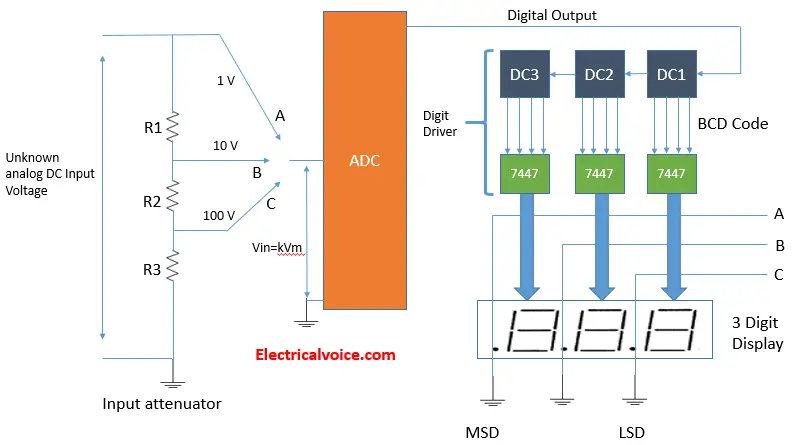A digital voltmeter (DVM) is truly a voltage measuring unit where unknown analog DC voltage is to be measured i.e. first converted to digital form and then displayed on seven segment display. The accuracy, versatility, precision, robustness of Digital electronic devices cannot be matched with that of Analog devices as the former ones are far more superior.
Contents
show
The building blocks for a digital voltmeter are input attenuator, ADC (Analog to Digital Converters), decade counters, 7447 IC, and digital readout.
Types of Digital Voltmeter
3. Continuous-balance DVM
4. Successive-approximation DVM
General Working of a Digital Voltmeter

- Based on the voltage range selected by the user, the unknown analog input signal is first attenuated.
- The attenuated voltage is converted to pulses by an ADC and pulses are counted by decade counter.
- The decade counter can count up to 9th clock pulse and gets reset on the 10th clock pulse.
- On receiving 10th clock pulse, the decade counter generates an overflow of the pulse.
- A 7447 IC is a BCD to 7 segment code converter.
- A decade counter and 7447 IC are combinedly known as a digit driver.
- Accumulated count in BCD code is converted into seven-segment code and driven to segment digit.
- The pulses produced by ADC are counted by the decade counter.
- The second decade counter counts the first decade counter overflow pulses and the third decade counter counts the second decade counter overflow pulses.
Advantages of a Digital Voltmeter
- Digital format display aids visual convenience.
- Read out of DVMs easily eliminates observational errors.
- They are very accurate and have high resolution.
- Compact & cheap.
- Low power requirements.
- They are robust and precise than their analog counterparts.
- Output can be fed to memory devices for storage and future computations.
- Error on the account of parallax and approximation is completely eliminated.
- Quick reading is possible.
- Portability is increased.
Features of the Digital Voltmeter
- Small size
- Easy construction
- Low cost
- Simple adjustment
- Easy to read from a distance
- Few external components
Q. What are the advantages of Digital voltmeters over analog voltmeters?
Answer.

